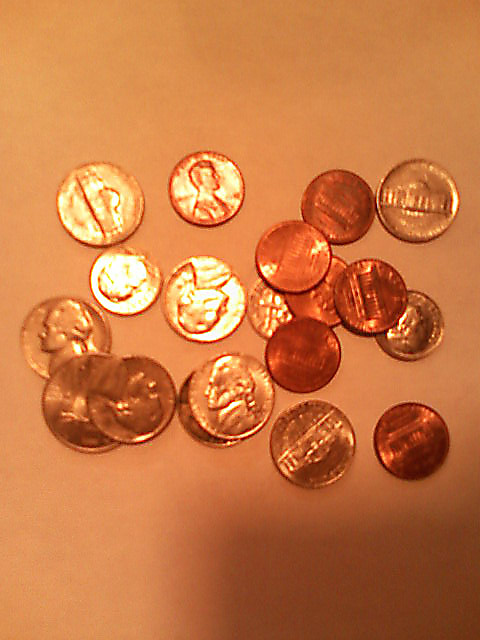¢OIN ISOLATION
One way to set up the board for
Coin Isolation is to first decide the order in which coins will be placed on the squares. Then put all of the coins in a cup, shake the cup, and sprinkle the coins out. The order of the coins is determined by the position of the center of each coin, from left to right. If it’s too close to call, then the coins go in order from highest to lowest vertically. If that doesn't do it, then use the last remaining dimension: top to bottom.
In this example, I decided to start in the upper-left corner of the board, move clockwise, and spiral inward. So I put the coins in a cup and sprinkled 18 of them on the table. This picture shows the result.

The coin that is furthest to the left is a nickel. So that nickel is placed in the first (upper-left corner) square on the game board. It's not so clear which of the remaining coins is furthest to the left. It's either the nickel (upper-left) or the quarter (lower-left). So the tiebreaker rule is required: The coin that is higher (closer to the top of the photograph) comes next. That's the nickel. Thus, the nickel takes square #2 and the quarter goes in square #3. Note that, if the two coins were still tied after the first tiebreaker, the second tiebreaker says that whichever coin was lying on top of the other would get square #2.
After that, a dime and a nickel are in contention for square #4. The rule says that the center of the coins are compared, so the dime comes first. Thus, the dime takes square #4 and the nickel goes in square #5.
The following diagram shows the locations of the first 18 coins.
|
5¢
|
5¢
|
25¢
|
10¢
|
5¢
|
1¢
|
5¢
|
5¢
|
|
|
|
|
|
|
|
5¢
|
|
|
|
|
|
|
|
10¢
|
|
|
|
|
|
|
|
1¢
|
|
|
|
|
|
|
|
1¢
|
|
|
|
|
|
|
|
1¢
|
|
|
|
|
|
|
|
5¢
|
|
|
|
1¢
|
5¢
|
10¢
|
1¢
|
1¢
|
Then I sprinkled more of the coins and continued the process until all of the coins were on the board.
